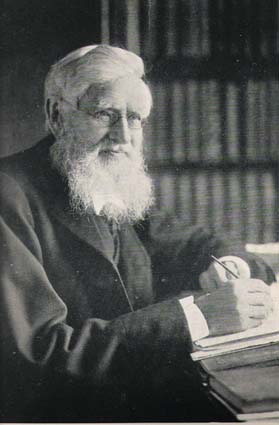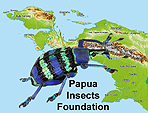

Papua-Insects.nl
The Papua Insects Foundation
Alfred Russel Wallace (1823-1913)
Alfred Russel Wallace (8 January 1823 – 7 November 1913) was a British naturalist, explorer, geographer, anthropologist and biologist. He is best known for independently proposing a theory of evolution due to natural selection that prompted Charles Darwin to publish his own theory.
Wallace did extensive fieldwork, first in the Amazon River basin and then in the Malay Archipelago, where he identified the Wallace Line that divides Indonesia into two distinct parts, one in which animals closely related to those of Australia are common, and one in which the species are largely of Asian origin. He was considered the 19th century's leading expert on the geographical distribution of animal species and is sometimes called the "father of biogeography". Wallace was one of the leading evolutionary thinkers of the 19th century and made a number of other contributions to the development of evolutionary theory besides being co-discoverer of natural selection. These included the concept of warning colouration in animals, and the Wallace effect, a hypothesis on how natural selection could contribute to speciation by encouraging the development of barriers against hybridization. Wallace was a prolific author who wrote on both scientific and social issues; his account of his adventures and observations during his explorations in Indonesia and Malaysia, The Malay Archipelago, was one of the most popular and influential journals of scientific exploration published during the 19th century.
Exploration and study of the natural world
Inspired by the chronicles of earlier traveling naturalists, including Alexander von Humboldt, Charles Darwin and William Henry Edwards, Wallace decided that he too wanted to travel abroad as a naturalist. In 1848, Wallace and Henry Bates left for Brazil aboard the Mischief. Their intention was to collect insects and other animal specimens in the Amazon rainforest and sell them to collectors back in the United Kingdom. They also hoped to gather evidence of the transmutation of species. Wallace and Bates spent most of their first year collecting near Belém do Pará, then explored inland separately, occasionally meeting to discuss their findings. In 1849, they were briefly joined by another young explorer, botanist Richard Spruce, along with Wallace's younger brother Herbert. Herbert left soon thereafter (dying two years later from yellow fever), but Spruce, like Bates, would spend over ten years collecting in South America.Wallace continued charting the Rio Negro for four years, collecting specimens and making notes on the peoples and languages he encountered as well as the geography, flora, and fauna. On 12 July 1852, Wallace embarked for the UK on the brig Helen. After twenty-eight days at sea, balsam in the ship's cargo caught fire and the crew was forced to abandon ship. All of the specimens Wallace had on the ship, the vast majority of what he had collected during his entire trip, were lost. He could only save part of his diary and a few sketches. Wallace and the crew spent ten days in an open boat before being picked up by the brig Jordeson.
After his return to the UK, Wallace spent eighteen months in London living on the insurance payment for his lost collection and selling a few specimens that had been shipped back to Britain prior to his starting his exploration of the Rio Negro. During this period, despite having lost almost all of the notes from his South American expedition, he wrote six academic papers (which included "On the Monkeys of the Amazon") and two books; Palm Trees of the Amazon and Their Uses and Travels on the Amazon. He also made connections with a number of other British naturalists—most significantly, Charles Darwin.
The Malay Archipelago and the Wallace Line
From 1854 to 1862, age 31 to 39, Wallace travelled through the Malay Archipelago or East Indies (now Malaysia and Indonesia), to collect specimens for sale and to study nature. His observations of the marked zoological differences across a narrow strait in the archipelago led to his proposing the zoogeographical boundary now known as the Wallace line. Wallace collected more than 125,000 specimens in the Malay Archipelago (more than 80,000 beetles alone). More than a thousand of them represented species new to science. In 1858 Wallace visited New Guinea at the western side but could not reach Misool for which he bounded. Instead he ended up at Waigeo and Salawati and later in Dorey (Manokwari) at the northeastern side of the Birdshead Peninsula. His assistent Ch. Allen did reach Misool in 1861. While he was exploring the archipelago, Wallace refined his thoughts about evolution and had his famous insight on natural selection. In 1858 he sent an article outlining his theory to Darwin; it was published, along with a description of Darwin's own theory, in the same year.
A map from The Malay Archipelago shows the physical geography of the archipelago and Wallace's travels around the area. The thin black lines indicate where Wallace travelled, and the red lines indicate chains of volcanoes
Accounts of his studies and adventures there were eventually published in 1869 as The Malay Archipelago. The Malay Archipelago became one of the most popular journals of scientific exploration of the 19th century, kept continuously in print by its original publisher (Macmillan) into the second decade of the 20th century. It was praised by scientists such as Darwin (to whom the book was dedicated), and Charles Lyell, and by non-scientists such as the novelist Joseph Conrad, who called it his "favorite bedside companion".
Warning colouration and sexual selection
In 1867, Darwin wrote to Wallace about a problem he was having understanding how some caterpillars could have evolved conspicuous colour schemes. Darwin had come to believe that sexual selection, an agency to which Wallace did not attribute the same importance as Darwin did, explained many conspicuous animal colour schemes. However, Darwin realised that this could not apply to caterpillars. Wallace responded that he and Henry Bates had observed that many of the most spectacular butterflies had a peculiar odour and taste, and that he had been told by John Jenner Weir that birds would not eat a certain kind of common white moth because they found it unpalatable. "Now, as the white moth is as conspicuous at dusk as a coloured caterpillar in the daylight", Wallace wrote back to Darwin that it seemed likely that the conspicuous colour scheme served as a warning to predators and thus could have evolved through natural selection. Darwin was impressed by the idea. At a subsequent meeting of the Entomological Society, Wallace asked for any evidence anyone might have on the topic. In 1869, Weir published data from experiments and observations involving brightly coloured caterpillars that supported Wallace’s idea. Warning colouration was one of a number of contributions Wallace made in the area of the evolution of animal colouration in general and the concept of protective colouration in particular. It was also part of a life-long disagreement Wallace had with Darwin over the importance of sexual selection. In his 1878 book Tropical Nature and Other Essays, he wrote extensively on the colouration of animals and plants and proposed alternative explanations for a number of cases Darwin had attributed to sexual selection. He revisited the topic at length in his 1889 book Darwinism.
The Wallace effect
In 1889, Wallace wrote the book Darwinism, which explained and defended natural selection. In it, he proposed the hypothesis that natural selection could drive the reproductive isolation of two varieties by encouraging the development of barriers against hybridisation. Thus it might contribute to the development of new species. He suggested the following scenario. When two populations of a species had diverged beyond a certain point, each adapted to particular conditions, hybrid offspring would be less well-adapted than either parent form and, at that point, natural selection will tend to eliminate the hybrids. Furthermore, under such conditions, natural selection would favour the development of barriers to hybridisation, as individuals that avoided hybrid matings would tend to have more fit offspring, and thus contribute to the reproductive isolation of the two incipient species. This idea came to be known as the Wallace effect. Wallace had suggested to Darwin that natural selection could play a role in preventing hybridization in private correspondence as early as 1868, but had not worked it out to this level of detail. It continues to be a topic of research in evolutionary biology today, with both computer simulation and empirical results supporting its validity.
On 7 November 1913, Wallace died at home in the country house he called Old Orchard, which he had built a decade earlier. He was 90 years old. His death was widely reported in the press. The New York Times called him "the last of the giants belonging to that wonderful group of intellectuals that included, among others, Darwin, Huxley, Spencer, Lyell, and Owen, whose daring investigations revolutionised and evolutionised the thought of the century."
Many insect species are named in honour of Alfred Russel Wallace, mostly beetles but also some butterflies and moths.
Full text of this biography on Wikipedia
updated on 10th October 2010